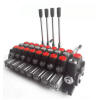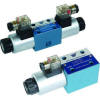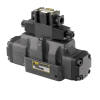| Hydraulic components
- Directional control valve |
|
Videos |
| https://www.iqsdirectory.com/articles/hydraulic-valve.html |
|
https://www.ifpusa.com/featured-products/directional-control-valves-dcv/ |
| Directional control
valves are third on our list of main hydraulic valve classification.
These valves allow fluid flow into more than one path when the fluid is
also coming from multiple paths, or even one source. They have a spool
inside that regulates which path is permitted to receive or give flow.
The position of the spool is the determining factor on which paths will
be active. They can be electronically controlled or manually controlled. |
| |
| Directional control
valves have three functions: |
- To isolate a certain
branch of a circuit
- Bypass valves or
return-line filters
- Deny flow in one
direction
- Protect hydraulic
components against surges in pressures
|
| These functions
typically operate in combinations. Most directional control valves
are of a spool-type design. A spool is used to control fluid flow and to
connect internal passages and port. The spool has lands and undercuts,
housed within precision-machined casing. As the spool shifts, the lands
and undercuts open and close flow paths. Spool-type valves are widely
used because they can be shifted to two, three, or more positions for
routing fluid between different combinations of inlet and outlet ports.
Ports refer to the number of lines into and out of the valve. They are
sometimes referred to as “ways”. For example, 4-way, 3 position valves. |
| |
| The actuator is a
mechanism used to move the position of the spool in a directional
control valve. The four basic methods of actuation include: |
- Manually-operated:
The spool is shifted manually by moving a handle, pushing a button,
or stepping on a foot pedal.
-
Mechanically-operated: The spool is shifted by mechanical linkages
such as a cam and rollers.
- Solenoid-operated:
When an electric coil or solenoid is energized, it creates a
magnetic force that pulls the armature into the coil. This causes
the armature to push the spool of the valve. It should be noted that
solenoids alone are not strong enough to move a directional control
valve spool when fluid flow is greater than 25 gpm and cannot
generate large forces unless supplied with large amounts of
electrical power. However, they are used extensively.
- Pilot-operated:
Pilot pressure is initiated when the fluid pressure in a fluid power
system shifts the spool into its desired position. By applying a
pilot signal (for either hydraulic or pneumatic systems) against a
piston at either end of the valve spool, pilot pressure is
introduced which pushes the piston to shift the spool.
|
 |
 |
 |
 |
|
Manual operated |
Mechanical operated |
Solenoid operated |
Pilot operated |
|
|
|
|
|
|
|
|
|
|
|
|
|
|
|
|



